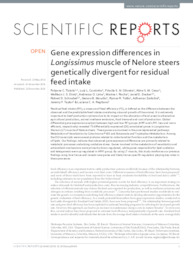Gene expression differences in Longissimus muscle of Nelore steers genetically divergent for residual feed intake.
Gene expression differences in Longissimus muscle of Nelore steers genetically divergent for residual feed intake.
Autoria: TIZIOTO, P. L.; COUTINHO, L. L.; OLIVEIRA, P. S. N.; CESAR, A. S. M.; DINIZ, W. J. S.; LIMA, A. O.; ROCHA, M. I.; DECKER, J. E.; SCHNABEL, R. D.; MOURÃO, G. B.; TULLIO, R. R.; ZERLOTINI NETO, A.; TAYLOR, J. F.; REGITANO, L. C. de A.
Resumo: Residual feed intake (RFI), a measure of feed efficiency (FE), is defined as the difference between the observed and the predictable feed intake considering size and growth of the animal. It is extremely important to beef production systems due to its impact on the allocation of land areas to alternative agricultural production, animal methane emissions, food demand and cost of production. Global differential gene expression analysis between high and low RFI groups (HRFI and LRFI: less and more efficient, respectively) revealed 73 differentially expressed (DE) annotated genes in Longissimus thoracis (LT) muscle of Nelore steers. These genes are involved in the overrepresented pathways Metabolism of Xenobiotics by Cytochrome P450 and Butanoate and Tryptophan Metabolism. Among the DE transcripts were several proteins related to mitochondrial function and the metabolism of lipids. Our findings indicate that observed gene expression differences are primarily related to metabolic processes underlying oxidative stress. Genes involved in the metabolism of xenobiotics and antioxidant mechanisms were primarily down-regulated, while genes responsible for lipid oxidation and ketogenesis were up-regulated in HRFI group. By using LT muscle, this study reinforces our previous findings using liver tissue and reveals new genes and likely tissue-specific regulators playing key-roles in these processes.
Ano de publicação: 2016
Tipo de publicação: Artigo de periódico
Unidade: Embrapa Pecuária Sudeste
Observações
1 - Por padrão são exibidas publicações dos últimos 20 anos. Para encontrar publicações mais antigas, configure o filtro ano de publicação, colocando o ano a partir do qual você deseja encontrar publicações. O filtro está na coluna da esquerda na busca acima.
2 - Para ler algumas publicações da Embrapa (apenas as que estão em formato ePub), é necessário ter, no celular ou computador, um desses softwares gratuitos. Sistemas Android: Google Play Livros; IOS: iBooks; Windows e Linux: software Calibre.
Acesse outras publicações
Acesse a Base de Dados da Pesquisa Agropecuária (BDPA) para consultar o acervo completo das bibliotecas da Embrapa.

